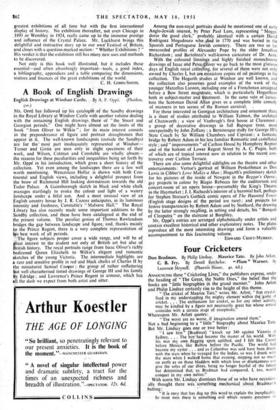A Book of English Drawings
English Drawings at Windsor Castle. By A. P. Oppd. (Phaidon. sos.) MR. OPPg has followed up his catalogbb of the Sandby drawings in the Royal Library at Windsor Castle with another volume dealing with the remaining English drawings there of " the Stuart and Georgian periods." One might have almost set the limits of the book " from Oliver to Wilkie " ; for its' main interest consists in the preponderance of figure and portrait draughtsmen that appear in it. The well-known landscapists (outside the Sandbys) are for thet most part inadequately represented at Windsor— Turner and Girtin are seen only in slight specimens of their work, and Wilson, Cotman and Constable are wholly absent— the reasons for these peculiarities and inequalities being set forth by Mr. Oppe in his introduction, which gives a short history of the collection. Yet even among the landscapes there are a few well worth mentioning. Wenceslaus Hollar is shown with both Con- tinental and English views, including a delightful prospect from the brow of Richmond Hill looking downstream towards the old • Tudor Palace. A Gainsborough sketch in black and white chalk manages startlingly to evoke the colour and light of a watery landscape under a fitful sun. And a most unusual view of an English country house by J. R. Cozens anticipates, in its luminous intensity and freshness, Constable's " Malvern Hall." The Royal Library has also recently made some important additions to the Sandby collection, and these have been catalogued at the end of the present volume. The peculiar genius of Thomas Rowlandson bridges the gap between landscape and figure, and, thanks mainly 4: the Prince Regent, there is a very complete representation of s best work of all periods. The figure subjects proper cover a wide range, and will be of treat interest to the student not only of British art but also of British history. The royal portraits range from Isaac Oliver's richly bedizened Queen Elizabeth to Wilkie's elegant and romantic sketches of the young Victoria. The intermediate highlights arc a rare and sensitive profile in red and black chalks of Charles II by the miniaturist Samuel Cooper ; the group of rather unflattering but well characterised tinted drawings of George Ill and his family
Edridge ; and Lawrence's Prince Regent in armour, which has all the dash we expect from both artist and sitter. Among the non-royal portraits should be mentioned one of early Anglo-Jewish interest, by Peter Paul Lens, representing " tviogge- dodo the good clerk," probably identical with a certain David Rodriguez Mogadouro who died in 1770 and was buried in the Spanish and Portuguese Jewish cemetery. There are two so far unrecorded profiles of Alexander Pope by the elder Jonathan Richardson ; and BartolOzzi's well-known caricature of Dr. Arm.
With the coloured limning's and highly finished monochrome drawings of Isaac and Peter.Dliver we go back to the most glorious days of English royal collecting, for several of them were not only owned by Charles 1, but are.miniature copies of oil paintings in his collection. The Hogarth studies at Windsor are well known, and the collection also possesses good examples of the work of the younger Marcellus Laroon, including one of a Frenchman arraigned before a Bow Street magistrate, which is particularly Hogarthian both in subject-matter and treatment. In the same vein of carica- ture the Scotsman David Allan gives us a complete little comedy of manners in ten scenes of the Roman carnival. .
For those interested in Georgian architecture and ornament there is a sheet of studies attributed to William Talman, the architect of Chatsworth ; a view of Vanbrugh's first house at Claremont ; a group of decorative drawings in full Baroque taste, most unexpectedly by John Zoffany ; a Berninesque study for George Ill's State Coach by Sir William Chambers and Cipriani ; a fantastic bridge by Robert Adam in his less familiar Romantic and castellated style ; and " improvements" of Carlton House by Humphrey Repton and of the bottom of Lower Regent Street by A. C. Pugin, both of which are of topical interest now in relation to the recent con- troversy over Carlton Terrace.
There are also some delightful sidelights on the theatre and other entertainments: Venue's .portrait of William Penkethman as Don Lewis in Cibber's Love Makes a Man; Hogarth's preliminary sketch for his pictures of the inside of Newgate in the Beggar's Opera; gay projects 'in colour by Biagio Rebecca for the auditorium and concert-room of an opera house—presumably the King's Theatre in the Haymarket ; J. I. Richards's interior of a baronial hall, perhaps for Stephen Storace's Gothick comic opera of The Haunted Tower (English stage designs of the period are rare); and projects for festive transparencies by Robert Adam and by. Stothard, the drawing by the latter strongly recalling, in setting and details, his " Banquet of Cleopatra " on the staircase at Burghley.
Mr. Oppes entries are arranged alphabetically under artists and contain excellent historical and other explanatory notes. The plates reproduce all the most interesting drawings and form a valuable accompaniment to this fascinating volume. • EDWARD CROFT-MURRAY.






































 Previous page
Previous page